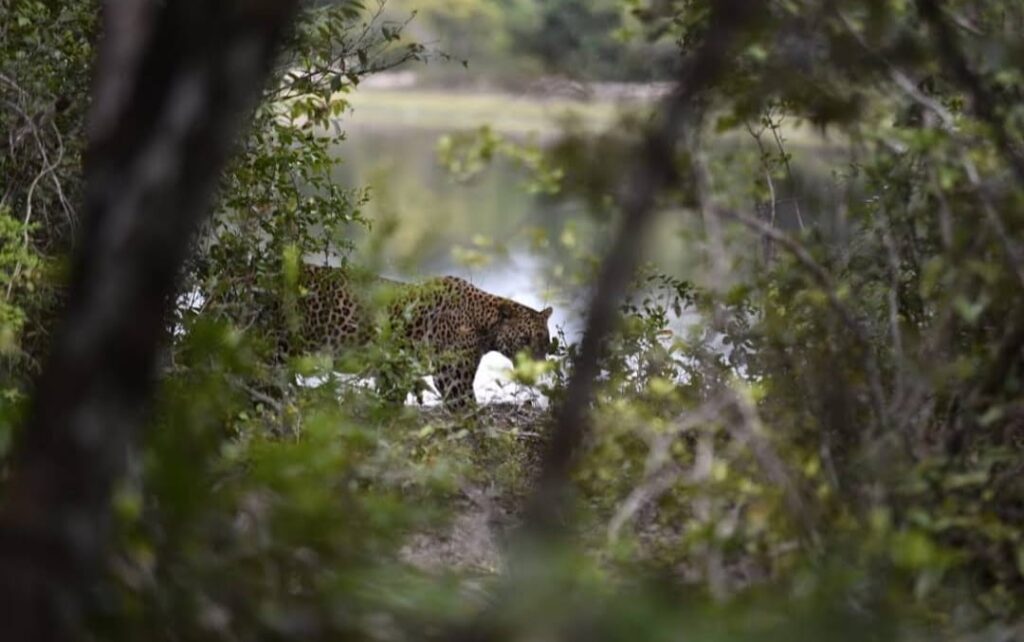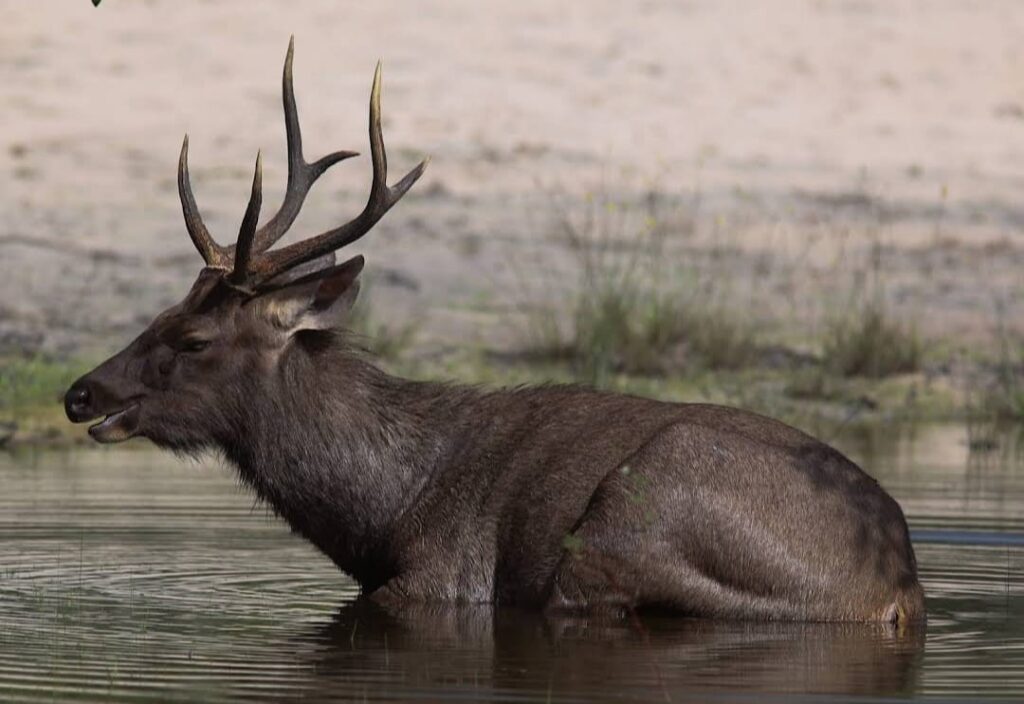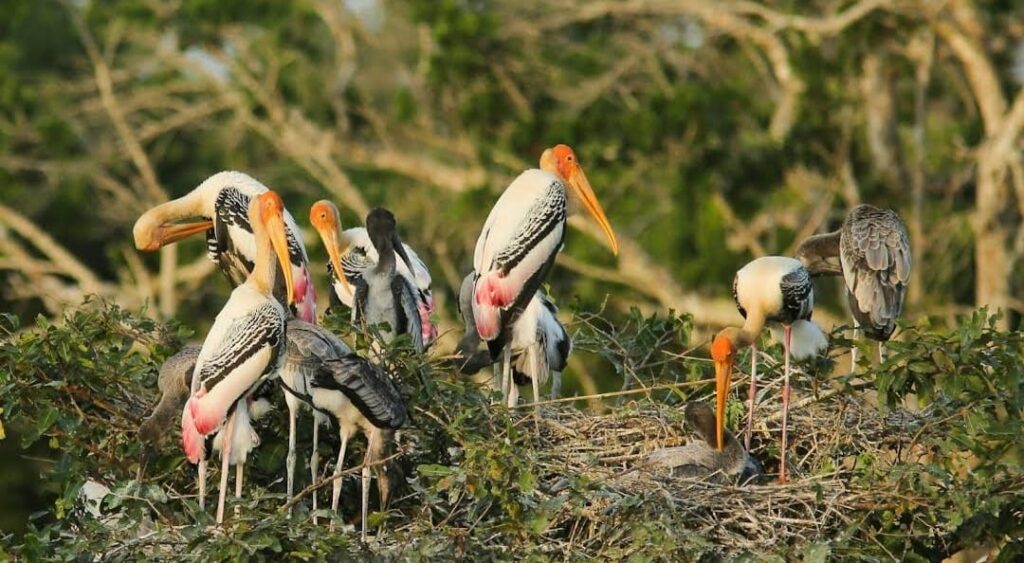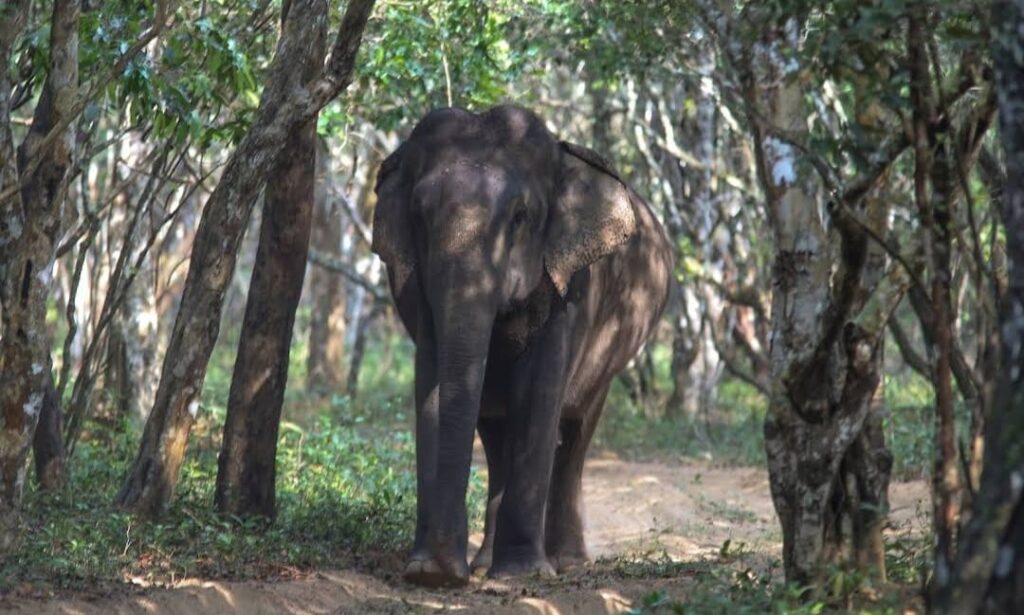
<h1>Wilpattu Hunuwilagama Half Day Safari</h1>Wilpattu Hunuwilagama Half Day Safari
Wilpattu Hunuwilagama Half Day Safari Experience a half-day safari through Wilpattu National Park via the Hunuwilagama Entrance. Spot leopards, elephants, sloth bears, and exotic birds with a professional guide. Comfortable Jeep and hotel pickup included.
Wilpattu Hunuwilagama Half Day Safari Tour Highlights
- Half-day safari (4–5 hours)
- Private or shared Jeep with experienced driver-guide
- Access through Hunuwilagama Entrance
- High chances to see leopards, elephants, sloth bears, crocodiles, and 200+ bird species
- Beautiful natural landscapes and park villus
Inclusions
- Licensed Jeep and driver-guide
- Hotel pickup and drop-off (Colombo, Anuradhapura, Puttalam, or nearby)
- Bottled water
Exclusions
- National park entrance tickets (paid at gate)
- Meals and personal expenses
Best Time to Visit
February to October. Morning safaris ideal for leopards; late afternoon for elephants and birds.
Price
Adults: EURO 55 | Children (5–12 years): EURO 28
Booking Form
Wilpattu Hunuwilagama Half Day Safari
Wilpattu Hunuwilagama Half Day Safari
Wilpattu Hunuwilagama Half Day Safari
Wilpattu Hunuwilagama Half Day Safari
Explore more safari options at our Wilpattu Eluwankulama Safari Packages page.
Check our full Pigeon Island Tours to plan your trip.




Wilpattu National Park – Hunuwilagama Entrance
Introduction to Wilpattu National Park
Wilpattu National Park, situated in the North-Western province of Sri Lanka, is the largest and one of the most beautiful national parks in the country, spanning over 1,317 square kilometers. Known for its unique “Willus” – natural lakes scattered throughout the park – Wilpattu is a haven for wildlife enthusiasts, bird watchers, and adventure travelers. The Hunuwilagama entrance serves as one of the main gateways to explore the untouched wilderness of this remarkable sanctuary.
Hunuwilagama Entrance Overview
Hunuwilagama Entrance is strategically located to offer easy access to the central and northern regions of Wilpattu National Park. This entrance is less crowded compared to the main park entrances, providing visitors with a more private and serene safari experience. The park office here provides visitor information, permits, and assistance for guided safaris. Hunuwilagama is especially recommended for wildlife photographers and nature enthusiasts who prefer a quiet and immersive encounter with Sri Lanka’s wilderness.
History of Wilpattu National Park
The history of Wilpattu National Park dates back centuries, with evidence of ancient settlements and Buddhist ruins scattered around the park boundaries. The name “Wilpattu” is derived from the Tamil word “Wil” meaning natural lakes, which are the lifeblood of this ecosystem. The park was declared a protected area in 1938 to preserve its unique biodiversity, particularly its population of Sri Lankan leopards, elephants, and endemic flora. Over the decades, the park has survived challenges such as deforestation, poaching, and regional conflicts, yet it remains one of the most pristine natural habitats in Sri Lanka.
Park Size and Landscape
Spanning approximately 1,317 square kilometers, Wilpattu National Park features a diverse landscape of dry forests, grasslands, and wetlands. The park is renowned for its over 50 natural lakes, known locally as “Willus,” which provide water sources for wildlife throughout the dry season. The terrain is mostly flat with occasional low hills, making it ideal for safari drives and wildlife spotting. Dense forests, scrublands, and open grasslands create a mosaic of habitats that support a rich variety of flora and fauna.
Flora of Wilpattu National Park
Wilpattu is home to a wide array of plant species, many of which are endemic to Sri Lanka. The vegetation is primarily dry zone forest, with some areas of scrub and grassland. Dominant tree species include:
- Palu (Manilkara hexandra)
- Yaka (Mesua ferrea)
- Rala (Terminalia bellirica)
- Kitul (Caryota urens)
- Ironwood (Mesua nagassarium)
The park also features a variety of shrubs, climbers, and medicinal plants. During the wet season, the landscape transforms into lush green forests with blooming wildflowers, making it a paradise for botanists and nature lovers.
Fauna of Wilpattu National Park
Wilpattu National Park boasts an impressive diversity of wildlife, making it a premier destination for safari enthusiasts. Some of the prominent species include:
- Leopards: Wilpattu is famous for its elusive Sri Lankan leopards, often spotted near Willus or dense forest areas.
- Elephants: Large herds of Sri Lankan elephants roam freely across the park, especially near water bodies.
- Sloth Bears: Though shy, sloth bears inhabit certain forested areas of the park.
- Deer Species: Spotted deer, sambar deer, and barking deer are commonly seen grazing on open grasslands.
- Wild Boar: These are widespread throughout the park.
- Primates: Toque macaques and grey langurs are frequently observed in the treetops.
- Birdlife: Over 200 bird species have been recorded, including Sri Lanka junglefowl, crested serpent eagle, and painted stork.
- Reptiles: Crocodiles, monitor lizards, and a variety of snakes inhabit the park’s lakes and forests.
Unique Features of Hunuwilagama Safari
The Hunuwilagama entrance offers access to some of the park’s most remote and pristine areas. Key highlights include:
- Willus Exploration: Safari drives take you along the park’s iconic natural lakes, where wildlife gathers for water.
- Bird Watching: Early morning safaris provide exceptional opportunities to photograph rare and endemic birds.
- Leopard Spotting: The dense forests around Hunuwilagama are ideal for glimpses of elusive leopards.
- Photography Tours: The natural landscapes, sunrise over Willus, and wildlife encounters offer unforgettable photography experiences.
- Eco-Tourism Experience: Visitors can enjoy a peaceful and environmentally conscious safari away from crowds.
Safari Tips for Visitors
- Start early in the morning for maximum wildlife sightings.
- Wear neutral-colored clothing to blend with the environment.
- Carry binoculars and a good camera for wildlife photography.
- Bring sufficient water, snacks, and sun protection.
- Respect the wildlife and maintain a safe distance from animals.
- Book safari guides through official park offices for safety and information.
Conservation and Protection
Wilpattu National Park plays a crucial role in wildlife conservation in Sri Lanka. The park is protected by the Department of Wildlife Conservation and contributes significantly to the preservation of endangered species, particularly leopards and elephants. Anti-poaching units and eco-tourism initiatives ensure sustainable visitation while maintaining the ecological balance. Visitors are encouraged to follow park rules strictly to minimize human impact.
How to Reach Hunuwilagama Entrance
The Hunuwilagama entrance is accessible by road from major cities like Colombo, Anuradhapura, and Puttalam. Well-maintained routes allow travelers to reach the entrance in a comfortable car or jeep. Guided tours and safari packages can be booked through official park websites and trusted tour operators such as wilpattu.vip. Early booking is recommended, especially during peak wildlife safari seasons.
Visitor Experience and Accommodation
Visitors entering through Hunuwilagama can expect a serene and immersive safari experience. Accommodation options near the entrance range from eco-lodges to luxury safari camps. Staying close to the park allows for early morning safaris, night drives, and extended exploration of remote Willus and forest areas. Many lodges also provide guided walking tours, bird watching sessions, and cultural experiences with local communities.
Best Time to Visit
The optimal time to visit Wilpattu National Park is during the dry season, from February to October. During this period, water sources are concentrated around the Willus, attracting a wide variety of wildlife. The monsoon months (November to January) see rougher weather and limited access to some areas of the park.
Conclusion
Wilpattu National Park’s Hunuwilagama Entrance offers an exceptional gateway into one of Sri Lanka’s most pristine natural landscapes. With its rich history, diverse flora and fauna, and serene safari experience, it is a must-visit destination for wildlife enthusiasts, photographers, and eco-tourists. Whether spotting a leopard near a Willu, photographing vibrant birdlife, or exploring ancient ruins, a visit to Hunuwilagama promises memories that last a lifetime. Book your next adventure through wilpattu.vip and experience the magic of Wilpattu National Park like never before.
Things to Do Around Wilpattu National Park
Wilpattu National Park, Sri Lanka’s largest and most pristine national park, is surrounded by a variety of attractions and activities that can make your trip unforgettable. From wildlife safaris to cultural explorations, nature walks, and eco-tourism experiences, there is something for every traveler. The park’s location in the North-Western province offers easy access to ancient cities, pristine beaches, and rural villages where you can experience authentic Sri Lankan life.
1. Safari Drives in Wilpattu National Park
The most popular activity around Wilpattu is undoubtedly the safari. Visitors can enjoy jeep safaris that traverse the park’s diverse landscapes, including dry forests, open grasslands, and the iconic “Willus” – natural lakes that attract wildlife throughout the year. Safaris can be arranged from various park entrances, including Hunuwilagama, Anuradhapura, and Kalpitiya.
Key highlights of a Wilpattu safari include:
- Leopard Spotting: Wilpattu is famous for its elusive Sri Lankan leopards. Early morning and late afternoon are ideal times for sightings.
- Elephant Herds: Large herds of elephants are commonly seen near waterholes.
- Bird Watching: Over 200 bird species, including endemic species, can be observed, making it a paradise for ornithologists.
- Wild Boars and Deer: Spotted deer, sambar deer, and wild boar roam freely throughout the park.
- Photography: The park’s landscapes and wildlife provide excellent opportunities for professional and amateur photographers.
2. Visit Ancient Ruins and Historical Sites
The region surrounding Wilpattu is rich in history and ancient ruins, providing a unique cultural complement to the natural beauty of the park. These sites include:
- Anuradhapura Ancient City: About 1.5–2 hours from Wilpattu, this UNESCO World Heritage Site is one of the oldest continuously inhabited cities in the world. Highlights include the sacred Sri Maha Bodhi tree, ancient stupas, and monastic ruins.
- Mihintale: Considered the birthplace of Buddhism in Sri Lanka, Mihintale is a pilgrimage site with stunning views and ancient stairways.
- Medieval Temples: Small, hidden temples near the park boundaries often feature frescoes and ancient sculptures.
3. Explore Nearby Villages and Rural Life
Visiting local villages around Wilpattu offers an authentic Sri Lankan experience. You can:
- Interact with villagers and learn about traditional farming and handicrafts.
- Sample local cuisine, such as rice and curry dishes prepared using organic ingredients.
- Participate in eco-tourism initiatives, such as tree planting and community-based wildlife conservation projects.
4. Nature Walks and Bird Watching
Beyond safari drives, guided nature walks in and around Wilpattu provide an intimate experience with flora and fauna. Early morning walks are ideal for observing endemic birds, insects, and small mammals. Birdwatchers can spot species like:
- Sri Lanka Junglefowl
- Crested Serpent Eagle
- Indian Peafowl
- Painted Stork and other wetland birds near Willus
5. Willu Exploration and Photography
The “Willus” are the heart of Wilpattu National Park. These natural lakes attract wildlife throughout the year and provide excellent opportunities for photography and wildlife observation. Some of the most famous Willus include:
- Parakrama Samudra
- Ketawala Willu
- Kudagammana Willu
Sunrise and sunset around these waterholes offer breathtaking views, perfect for landscape photographers.
6. Jeep Safari Packages and Custom Tours
Several safari operators near Hunuwilagama entrance offer full-day, half-day, and custom safari packages. Visitors can tailor their trips based on interests, such as:
- Wildlife photography tours
- Birding-focused safaris
- Leopard spotting tours
- Family-friendly guided safaris
Booking through official operators ensures safety, local knowledge, and adherence to park regulations.
7. Eco-Tourism and Conservation Activities
Wilpattu and the surrounding areas encourage responsible tourism. Visitors can engage in conservation efforts, including:
- Guided tree planting activities near the park boundary
- Volunteering with local wildlife awareness programs
- Supporting community-based eco-lodges and sustainable tourism projects
8. Camping and Night Experiences
For adventure travelers, several eco-lodges and camping sites around Wilpattu allow overnight stays close to the park. Night drives and nocturnal wildlife tours can reveal unique species such as civets, mongooses, and porcupines. Campfires under the stars, with the sounds of the wild all around, provide a truly immersive experience.
9. Visiting Nearby Beaches and Coastal Attractions
While Wilpattu is inland, its proximity to Sri Lanka’s west coast allows day trips to serene beaches. Popular nearby destinations include:
- Kalpitiya: Famous for dolphin watching, kite surfing, and coastal fishing.
- Puttalam Lagoon: A scenic area for birdwatching and mangrove exploration.
10. Local Cuisine and Culinary Tours
Sampling local food around Wilpattu is a delight. Options include:
- Traditional rice and curry meals made with locally grown ingredients.
- Freshwater fish from nearby rivers and lakes.
- Sri Lankan desserts like wattalappam and kiri bath.
- Cooking demonstrations with villagers and local chefs.
11. Adventure and Outdoor Activities
Beyond wildlife safaris, the area offers adventure opportunities:
- Hiking through dry forests and scrublands
- Photography expeditions at sunrise around Willus
- Birdwatching tours with professional guides
- Nature-inspired art and sketching sessions
12. Cultural and Religious Tours
The North-Western province is rich in Buddhist and Hindu heritage. Nearby attractions include:
- Ancient Buddhist temples and stupas in Anuradhapura
- Local festivals and traditional ceremonies in nearby villages
- Historical ruins showcasing Sri Lanka’s medieval history
13. Practical Tips for Visitors
- Best time to visit: February to October (dry season for wildlife spotting)
- Carry water, sunscreen, insect repellent, and binoculars
- Hire experienced guides for better wildlife sightings and safety
- Respect park rules and wildlife; do not feed animals
- Book safari and accommodation in advance during peak season
14. Summary
A trip to Wilpattu National Park is more than just a wildlife safari. With historical exploration, cultural experiences, eco-tourism, and adventure activities, the region surrounding Wilpattu offers an unforgettable experience. Whether you are a wildlife enthusiast, history lover, adventure traveler, or someone seeking peace in nature, Wilpattu and its surrounding areas have something special to offer.
About Kalpitiya
Introduction to Kalpitiya
Kalpitiya, located on the north-western coast of Sri Lanka, is a hidden gem famous for its stunning beaches, lagoons, wildlife, and adventure activities. Just a short drive from Wilpattu National Park, it combines natural beauty with a relaxed coastal atmosphere, making it a must-visit destination for travelers seeking both wildlife and seaside experiences.
Beaches and Coastal Beauty
The pristine beaches of Kalpitiya stretch along the Indian Ocean, offering soft sands and turquoise waters. Visitors can relax, swim, or enjoy long walks along the coastline. Some of the popular beaches include:
- Kalpitiya Beach – ideal for sunrise views and calm waters.
- Delft Island Beaches – reachable by boat, known for remote and untouched shores.
- Thalawa and Palavi Beaches – excellent for nature photography and beach camping.
The coastline is also a hotspot for water sports such as kite surfing, windsurfing, and snorkeling.
Dolphin and Whale Watching
Kalpitiya is famous for its dolphin and whale watching tours. The area hosts large pods of spinner dolphins, and seasonal sightings of blue whales, sperm whales, and even orcas have been reported. Tours usually start early in the morning, offering calm seas and excellent chances for wildlife photography. Many local operators provide safe, eco-friendly tours ensuring minimal impact on marine life.
Kite Surfing and Water Sports
The flat lagoons of Kalpitiya make it one of the top kite surfing destinations in Asia. The windy season from May to October is ideal for both beginners and professional kite surfers. Certified instructors, equipment rental, and courses are widely available. Other activities include stand-up paddleboarding, kayaking, and snorkeling in the lagoon and coastal waters.
Kalpitiya Lagoon and Eco-Tours
The Kalpitiya Lagoon is a unique ecosystem, rich in mangroves, estuaries, and wildlife. Eco-tours explore this natural habitat, offering glimpses of birds, monkeys, and small reptiles. Kayaking through the mangroves or taking a guided boat tour allows visitors to experience the tranquility and biodiversity of the area. Notable wildlife includes:
- Various species of herons, egrets, and kingfishers
- Long-tailed macaques and monitor lizards
- Colorful marine fish in shallow lagoon waters
Wildlife and Bird Watching
Kalpitiya is not just a coastal destination; it is also home to fascinating wildlife. Bird watchers can spot flamingos, pelicans, cormorants, and migratory species. The nearby Wilpattu National Park adds to the wildlife experience, allowing visitors to combine a safari with coastal exploration.
Cultural and Historical Sites
Kalpitiya has a rich cultural history influenced by Portuguese, Dutch, and local Sri Lankan heritage. Some sites of interest include:
- Dutch Fort – built during the colonial era, offering panoramic views of the lagoon.
- Local Fishing Villages – where visitors can learn traditional fishing methods.
- Religious Sites – including Hindu temples and Buddhist shrines, reflecting the diversity of the region.
Adventure and Eco-Tourism Activities
Beyond beaches and safaris, Kalpitiya offers a range of adventure activities. These include:
- Nature trekking in coastal and mangrove areas
- Camping on secluded beaches
- Photography tours focusing on wildlife and coastal landscapes
- Participating in community-based eco-tourism and conservation projects
Accommodation and Travel Tips
Kalpitiya offers a variety of accommodation options ranging from budget guesthouses to luxury eco-lodges. Staying near the lagoon or beach allows easy access to water sports, dolphin tours, and sunset views. Travel tips for visitors include:
- Best time to visit: May to October for kite surfing and marine life sightings.
- Carry sunscreen, hats, and insect repellent for outdoor activities.
- Hire local guides for eco-tours, dolphin watching, and cultural exploration.
- Respect local traditions and wildlife during your visit.
Nearby Attractions
Kalpitiya is well-connected to other attractions, making it ideal for multi-destination trips:
- Wilpattu National Park – only a short drive inland, ideal for safari experiences.
- Delft Island – accessible by boat, perfect for history, wild donkeys, and remote beaches.
- Puttalam Lagoon – for bird watching and scenic boat tours.
Conclusion
Kalpitiya is a perfect destination for travelers seeking a combination of wildlife, adventure, and coastal relaxation. From kite surfing in the lagoons to dolphin watching, nature walks, and cultural exploration, it offers a diverse and memorable experience. Whether visiting for a day trip from Wilpattu National Park or staying longer to explore the coast, Kalpitiya is a hidden paradise waiting to be discovered.
Plan your visit and book your Kalpitiya tours through wilpattu.vip for a seamless and unforgettable experience.
Wilpattu Hunuwilagama Half Day Safari Wilpattu Hunuwilagama Half Day Safari Wilpattu Hunuwilagama Half Day Safari Wilpattu Hunuwilagama Half Day Safari Wilpattu Hunuwilagama Half Day Safari Wilpattu Hunuwilagama Half Day Safari Wilpattu Hunuwilagama Half Day Safari Wilpattu Hunuwilagama Half Day Safari Wilpattu Hunuwilagama Half Day Safari Wilpattu Hunuwilagama Half Day Safari Wilpattu Hunuwilagama Half Day Safari Wilpattu Hunuwilagama Half Day Safari Wilpattu Hunuwilagama Half Day Safari Wilpattu Hunuwilagama Half Day Safari Wilpattu Hunuwilagama Half Day Safari Wilpattu Hunuwilagama Half Day Safari Wilpattu Hunuwilagama Half Day Safari Wilpattu Hunuwilagama Half Day Safari Wilpattu Hunuwilagama Half Day Safari Wilpattu Hunuwilagama Half Day Safari Wilpattu Hunuwilagama Half Day Safari Wilpattu Hunuwilagama Half Day Safari Wilpattu Hunuwilagama Half Day Safari Wilpattu Hunuwilagama Half Day Safari
